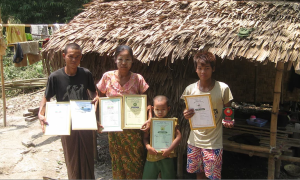Q. What is it like in a village without one of your schools?
A. There are, sometimes other school structures. They may be made of bamboo walls and thatched roofs, with earth floors or they may have been more solid in decades past but have deteriorated or the children may be taught under a tree.

Q. How is going to school in Myanmar different than in Canada?
A. One of the most obvious answers is how children get to school. They walk, sometimes for miles to arrive at the beginning of the day and repeat to get home when school finishes. When they can arrive to a dry building during monsoon season or a cooler building during the hot season, then there is a space that is more conducive to being warm, dry and able to learn.

Q. Is this really what people in Myanmar want or is it a first world country deciding that education is a good thing to do?
A. The first time Gilly went to Myanmar in 2005, she saw many many books that were so thumbed through they were 10 times thicker than their initial size. It was in 2005 and at that time there was one computer accessible to foreigners in the country. Everyone was hungry for information. There have been great changes over the years.
Q. How do the school buildings benefit the students?
A. The school buildings benefit the children, the teachers and the community. The children can learn much more quickly when they are in a building that is warm when it is cold outside and cool when it is hot. There is also less distraction from noise. So the teachers find that it is easier to teach and the children learn in one day what would have taken four days previously.
One of the first schools we built was to replace a school with mud floors and bamboo woven walls. This structure was OK in the warm season, but in 5 degrees celcius and monsoon weather was a different story.
Another benefit to the structure is unforeseen from a country such as Canada where there are many community buildings. The school becomes a gathering place – not only for that village, but for many villages around. The children come during the day and adults come to learn, debate, celebrate in the evenings.

Q. How are the scholarship recipients chosen?
A. John asks the headmasters in the schools to keep an eye open for whom they think is a special student who comes from a poor family. In the case of one student, the whole village came forward and asked if we could help him further his education as he had always come first in his class and wants to be a teacher when he grows up. His family “does not have a bean” as is the case with another scholarship recipient.

In order to continue to get a scholarship you must show continual good grades.
Q. Do you use any donated $ to go to Myanmar?
A. No, our trips to Myanmar are funded by ourselves. When we can afford to go! Because so very little money goes so far, 100% of monetary donations are applied to the projects. We have great confidence that John and Maung Maung Gyi do a great job and do not require on-site visits. When we have gone, either together or separately, we have been blown away by what they accomplish.

Q. What are your administrative or hidden costs?
A. We do not have administrative costs as our organization is run entirely by volunteers in Canada. We are transparent and accountable through annual directors meetings.

Q. Can I receive a tax receipt for my donation?
A. In brief, no.
As a registered nonprofit, we have more flexibility than a charity. We can have a scholarship fund. We can provide school books, computers and supplies… your donation is current. It will go to support the children where they need it the most, today.
Other charities now support the building and maintenance of schools. John and Maung Maung Gyi are progressive and see different areas that children need support.
All donations made to UR Building Knowledge are to a nonprofit organization – registered in Canada. We do give receipts that are not redeemable for tax.
Q. How does it benefit me?
A. It’s good for the heart to give. It’s also good to know that your donation goes where you want it to, so you have peace of mind.


